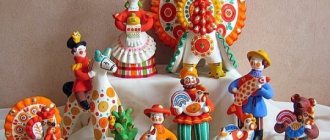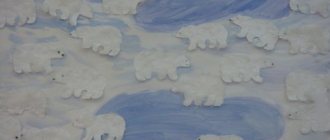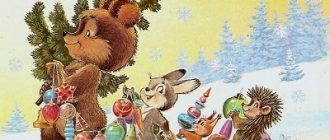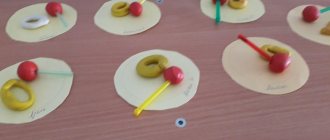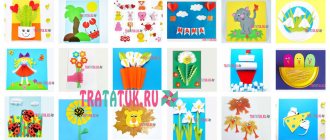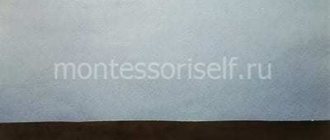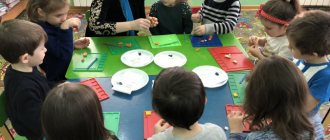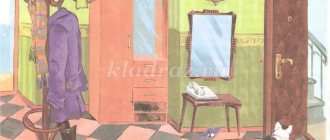Choosing plasticine
When purchasing plasticine, you need to carefully read the instructions from the manufacturer and make sure that it is appropriate for the child’s age and suitable for modeling purposes.
Classic hard plasticine is a durable material, crafts made from which are durable, but this property can also be a disadvantage, since very young children may not be able to handle it.
Light plasticine is a soft, bright material with natural dyes, easy to clean, suitable for children of any age;
The modeling compound is a very practical and easy-to-use material, it doesn’t stick, it retains its plasticity for 12 hours; the downside is the high price.
Ball plasticine is an excellent material for small children’s hands; it is often used for additional decoration of ready-made figures; it is fragile, but due to its characteristics, the child must be under the constant supervision of adults while sculpting.
Floating plasticine will give children a lot of pleasure, as it is soft, does not stain hands and clothes, and figures made from it float on the water.
Modeling paste - resembles clay, ideal for creating solid figures, since parts made from paste do not stick to each other, suitable for painting.
Thus, for playing with children, it is better to take light plasticine in bright colors, as well as hard material to create more durable and long-lasting crafts. You should not choose sets with strong flavors and artificial colors - they can cause allergies.
Birds
Sculpting birds is quite difficult, but you can try to make a white swan:
- A body with an elongated tail is sculpted from an oval.
- Attached to the sides are two flat, smaller ovals, pointed at one end - wings.
- The long piece is used to make a curved neck and a larger head.
- Eyes are made on the head, the beak is made from a small piece of red color.
If you take black plasticine, you will get a swan of a rare shade.
Cartoon characters
Peppa Pig is a popular pig from the children's cartoon and a good exercise for developing motor skills:
- Two balls are molded - pink and red.
- The pink ball is given the shape of a head with an elongated snout, and the red one should make a dress with a hem, the resulting parts are connected.
- Two thin arms, two thicker legs and a curled tail are sculpted from pink plasticine.
- Two pink ears are attached to the head, white eyes with black pupils, and the snout, cheeks and mouth are made of dark pink so that they stand out.
Making your own favorite cartoon character with so many small details is a real achievement and creative success for a child.
Fantastic creatures
If you know how to sculpt a horse, you can simply turn it into a mythical creature - a unicorn:
- A horse is several oval parts connected together. The main thing is to maintain proportions. The color can be any, for example pink.
- The head with ears is connected to the neck, the neck is connected to the body.
- Four thinner elements form the legs. Small hooves made of black plasticine are attached to them at the ends.
- The mane and tail are made from thin elements. They may be of a different color.
- And the final element that will turn a simple horse into a unicorn is a horn on the head of a bright shade. The front legs can be bent so that the horse appears to be walking.
After completing the modeling, the remaining plasticine must be sorted into colors so that it does not stick together in the box, otherwise it will harden and then be difficult to separate. Hands must be washed with soap and water.
Modeling various animals from plasticine is a great activity for children and parents. It promotes perseverance, develops attention to detail, imagination and independence.
Progress of the lesson
Read the poem “Turtle” by R. Desnos to the children:
I am a turtle, Therefore it is clear that I am both smart and beautiful.
And the fact that like a swallow, I am not winged, So it’s not me, But fate is to blame.
But being dissatisfied with your destiny does not mean being dissatisfied with yourself.
Ask the guys: “Who is this poem about? (About the turtle.) What does the turtle think about itself?” (That she is smart and beautiful.)
Invite the children to make a chestnut turtle. Explain the sequence of work: the nut is coated with plasticine on all sides. Then a pistachio shell is fixed on top of it, forming a turtle shell. The head with neck, legs and tail are created from separate parts of plasticine and attached to the lower part of the turtle's body. All that remains is to design the face.
These funny animals
Children are keenly interested in animals: they surround them at home, they appear in books and cartoons, so it will not be difficult for an adult to explain and show a child how to make animals from plasticine.
Modeling such figures is a labor-intensive process, but with due diligence the result will not disappoint and will instill in the child confidence in his abilities. So, we sculpt animals from plasticine.
Pets
Pets made from plasticine are a good idea for modeling, since the child could see a cat or dog in person and will now try to make them from plasticine. This develops imagination. You can try to make a red cat:
- Take orange plasticine and mold a flat elongated oval - from this one piece you will get a body and four legs.
- Using a knife, two cuts are made at the ends of the part - you get two paws on both sides, and a back in the middle.
- The oval is bent in the middle so that the figure stands on its paws, arching its back.
- The head with ears is attached on one side, and the tail on the other.
You can make a mustache from scrap materials. The cat is ready!
Progress of the lesson
Give the children a riddle:
I didn’t tremble before the wolf, I ran away from the bear, But I still got caught in the teeth of the fox... (Kolobok)
Ask the children: “If Kolobok found himself in a winter forest, what animals would he meet there?” (A white hare, a hungry wolf, a bear sleeping in a den, a cunning fox.)
Group children into groups of 6. Tell them that today in class they will make a winter forest through which Kolobok will travel. The box lid will turn into a forest using tree branches attached to plasticine. On blue cardboard you need to draw several snow-covered fir trees and trees, the sun, using white gouache using the dry brush method. Glue the cardboard perpendicularly to the back side of the box to create a forest panorama. Attach a den (a semi-oval jar, for example, from yogurt) to plasticine. Place cotton wool in the form of snow at the bottom of the box and on tree branches.
While two children are decorating the forest, the rest of the children can sculpt one animal each - an inhabitant of the forest: a body from a roller; paws and tail from columns, pull out a muzzle from a rolled ball and, where necessary, blunt it with your fingers; pinch your ears. The one who completes this task faster will have time to fashion a Kolobok (plasticine ball). All that remains is to place the heroes in the winter forest and hide the sleeping bear in a den.
Lesson 19. Sheep (Decorative clay plate)
Program content. Teach children to depict the relief of an animal in the form of a decorative plate. Learn to trace a template with a stack and use it to remove excess clay. Continue to learn how to independently bring a product to the intended image using various tools. Develop imaginative thinking.
Material. Subject picture with a sheep. Clay, sheep silhouette templates, rolling pins, spade rolls, felt-tip pen caps, bowls of water, cardboard stands, modeling boards (for each child).
